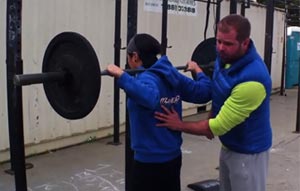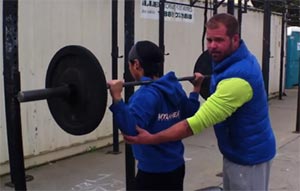Kelly Starrett takes another look at the Front Rack Position.
First part is about keeping a stable, externally rotated rack position is really good.
Second part is about pointing the elbows down when doing back squats.
For example he says that it unloads the wrist and makes the back more stable.
Here are both versions in comparison. Which has less pressure on the wrists and has a tighter back?


First I thought that elbows back was pretty much how every Olympic lifter squats, but then I took a look at the archive.
It seems to come down to personal preference.
See for example Clarence Kennedy’s squat. As you can see his elbows are back and up. His entire upper back is a tight shelf (I would argue tighter than you can get with elbows down) and he still keeps forces his chest up.
Elbows Back Lifters: Some do it more pronounced than others. Ivan Stoitsov does it, Kendrick Farris has his elbows back, same as Pat Mendes, Josh Gilbert, Milko Tokola the Cal Strength lifters, Jessia Salvaggio or Summer Krasinski.
Elbows Down Lifters: most of them still tuck them back a little when coming out of the hole. Idalberto Aranda keeps them way down , as does Fernando Reis. Jirka Orsag also keeps them fairly down.
Your thoughts?
I’ve tried both. The bar feels more secure with the elbows up but my core gets weak. When elbows are down, my lats and back feel tighter, chest stays up and core stays braced and stable.
i did elbows back + false wide grip when i first started learning squats (starting strength style), but when i transitioned to olympic lifting, i changed to elbows down + regular narrow grip. i don’t know how it affects that “shelf” for me, but keeping elbows down helps my torso stay upright on the ascent as i consciously try to push the bar up as i’m standing up.
for me, elbows back helped out for low-bar squatting, and elbows down was better for olympic squats.
To be fair I don’t think anyone has cued elbows to be back ever in any squat style, PL or OL. Shoulders back/back tight should be the cue. There’s a decent article here which is worth a read:
http://squatrx.blogspot.co.uk/2010/02/elbow-positioning-when-squatting.html
Ultimately like Kirksman pointed out on http://www.lifthard.com about 3 articles ago about foot positioning while squatting. It doesn’t matter, you get people squatting massive weights with both technique the only thing similar between the two groups are persistence and consistency.
Good points, thanks.
I agree with Wilmar on this. If you are doing low bar squats it is necessary to keep the elbows back in order to keep the bar secure. Once you transition to Olympic style, keeping the elbows down increases core stability, allowing for the lifter to keep their chest up.
I tried to keep them down today, but for me it felt more natural to tuck them back a bit. I know I am lacking mobility and probably also lack a great deal of core power. So that may be my body compensating for the deficiencies.
I don’t look at it as two distinct things. I tend to set up and descend with elbows actively pulled down to stabilize the upper back. At the bottom of the descent and in driving out of the hole, my elbows come up a bit (passively). Then driving through the sticking point/parallel I push them forward as far as possible (I find this helps wedge the hips forward on very hard reps or adds speed to reps with sub-maximal weights).
Gregor, it might just be me, but doesn’t it seem that Kelly Starrett is talking about two extremes in his video? I mean, look at the height that the girl’s elbows are up – they’re closing in on being parallel with the floor! Now take another look at some of the squatters you posted who have their elbows back – how far back are they REALLY? Seems to be more of a middle-ground to me at least.
Yep, you are right, he is talking about the 2 extremes.
But I would say there are still 2 kinds of lifting style, some with more, some with less pronounced elbows back position.